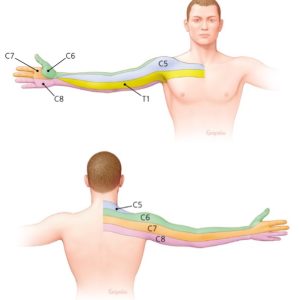HOW ARE REFERRAL PAIN AND CERVICAL RADICULOPATHY CONNECTED?
Cervical radiculopathy is literally a pain in the neck.
In some circumstances, the anatomy of the neck can result in referred pain, a form of pain occurring in one part of the body due to an injury located in a different area of the body.
When suffering from neck injuries, people may frequently describe feeling discomfort in the elbow, hand and shoulder. The pain is reported as a burning sensation, a persistent aching or a pins and needles tingling sensation.
While these feelings can be concerning the cause of the pain is straightforward. The nerves coming out of the spinal cord openings, called vertebral foramen, have been damaged.
The reason these foramina become damaged varies and the damage ultimately results in nerve irritation. Causes include herniated or bulging discs and the narrowing of space between the joints as a result of increased stiffness or degeneration. Due to the peripheral nature of the irritation, these referral symptoms will be unilateral in nature. In severe cases, patients can feel discomfort in both arms.
DISTRIBUTION OF REFERRAL PAIN
The location or distribution of referral pain is dependent on the location of the nerve irritation in the spine.
As each root supplies sensory and motor input to different areas of the arm, symptoms will usually follow a specific distribution or region of the arm, known as dermatomes.
The picture illustrates these patterns (C = cervical vertebrae, T = thoracic vertebrae, number indicates differing spinal level):
For example, someone with a C6 radiculopathy and corresponding referral pain will often feel symptoms along the outside of their arm, descending to the thumb.

HOW CAN REFERRAL PAIN BE MANAGED?
Manual therapy has been shown to beneficial for pain relief and improvements with function when combined with exercise interventions. However, as a stand-alone treatment, it has only been shown to provide short term relief.
Exercise therapy has been consistently demonstrated to have the most positive and lasting effects for the condition.
Exercises targeted at opening the intervertebral foramen and stabilising the resultant openings through strengthening programs are often the first line of treatment that a physiotherapist will employ.
Physiotherapy for cervical radiculopathy ensures that both short-term and long-term relief are achieved.
Furthermore, your physiotherapist may also include some exercises aimed at reducing the neurological referral symptoms down your arm.
Adherence to exercise programs is essential to reducing pain and improving long term function. And as such, your own role in your wellbeing is essential.
Cervical radiculopathy and referred pain can be a scary situation to patients initially, but when managed correctly using a combination of manual therapy, exercise programs and education, the prognosis has been shown to be positive.
If you are experiencing any of the symptoms above and believe you need neck injury rehabilitation call 07 3352 5116 or make a booking with Pivotal Motion Physiotherapy and get care from a physiotherapist Brisbane trusts today!

